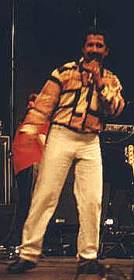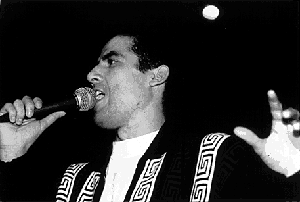In this section I will briefly point to the principal
stages of raï transformation during its history. It is
important to underline that this is only a brief sketch
of raï's musical transculturation stages. In realityt
they cannot be divided in such a definite way since they
sometimes developed side by side.
-
- The Origin of Raï Music
- Raï music stemmed from the relationship between
the urban culture of Oran and the rural culture
of the surrounding countryside (Virolle 1995).
Internal rural emigration towards the coastal
towns was the external factor which allowed the
meeting of the bédui country singing
style and the more urbanized zéndani.
The singers in this new style were called cheik
(master) for men and cheikha for women.
They sang together with Jewish players, experts
in the Arab–Andalusian style, in the
Arab-cafés. The common repetition in their texts
of the expression ya-rayi (my thought)
brought some people to define this style as raï.
-
- From Colonialism to Independence
- Colonialism made more cultural contacts easier.
Many cheikh and cheikha sang in cafés for
the French troops. Cheikha Rimitti was one of
these singers. In these places the radios often
played Egyptian music but also French music. The
experience of the two world wars also put some
singers in contact with American music. All these
cultural contacts influenced raï, which
responded by showing a certain degree of
rebelliousness against colonialism but also
against Algerian social rules. At this time raï
songs seemed to ask more for social change than
revolution. In fact, in 1954 one of
Rimitti’s most famous songs was Charrag
gataâ (tear, lacerate) in which the singer
urged girls to break the taboo of
virginity.
- At the same time Houari Blaoui looked for new
musical possibilities using for the first time
rhythms coming from American music such as
foxtrot, bebop, and boogie-woogie. From this time
there were different styles of raï music and
there were different sound groups identified with
one style or another.
-
- From Bars to Marriage Parties
- During the 1950s Algerian people considered raï
as a music for disreputable places such as bars,
cafés located near Oran’s port, and even
brothels. But the maddahat, groups of
women singers that liven up the marriage parties,
started to use raï as part of their repertoire
(which was mainly religious). This was
possible because during these parties moral rules
are less rigid (Virolle 1995). As a consequence,
the image of raï music and its audience improved
at the social level, because marriage parties
have a special status in Algerian society.
Moreover, other young singers saw the possibility
of making some money by performing raï during
these parties, as the maddahat did. The
most famous of these young singers was the future
Cheb Khaled.
-
- Pop-raï

Khaled |
Messaoud Bellemou coined the
term pop-raï in 1974. He was the first trumpeter
to accompany a raï singer, Bouteldja. The
definition pop-raï was needed to indicate that
the new style dealt with jazz, rock and
Afro-American rhythms. The introduction of
electronic keyboards characterized the sound of
this style and allowed the singer to play alone,
so many young people decided to attempt a career
as a singer. They were called cheb in
contraposition to the cheikh and their old
style. The texts of pop-raï dealt with love, in
particular forbidden loves, sadness, alcohol,
etc. The soundtracks of Egyptian, American and
Indian films had a heavy influence upon this new
generation of singers. |
- Raï-love
- During the 80s raï music was at the top of its
success and popularity. In order to increase
their customers the raï producers asked raï
singers to avoid harsh words and expressions.
Cheb Hasni was the most famous singer of this
style whose texts spoke in particular of love and
France. So it was named raï-love. This
music is a point of contact between the Algerian
and French coasts because Algerian immigrants,
especially women, greatly enoy this style.
-
- Raï made in France
- In the same period many raï singers emigrated to
France. In Algeria they were scared by terrorism,
but they were also looking for new places to
sing. In 1986 the concert in Bobigny (Paris) made
the contact between these raï singers and the
French and international record companies easier.
Khaled, Mami, Fadéla, Zahouania and others began
working for the most important major company.
Contact with the musical market has transformed
raï music so much that now one speaks of French-raï.
This genre is not very appreciated in Algeria,
but in the same time sales in the world music
category show a relevant market success.
-

Cheb Mami
- Raï-beur
- Beurs developed a certain interest for
raï music after the Bobigny concert because for
many beurs this concert was their first
direct contact with raï music. Raï music was
meant as the most rebellious and transgressive
expression of the Algerian cultural heritage, and
at the same time it was easily modifiable
according to the beurs' need for a musical
identity. Some of them had played and sung other
musical styles such as rap, jazz and rock, which,
reinterpreted and mixed with raï music, produced
a new and peculiar raï. Cheb Khader was probably
one of the first raï-beur singers, but in
a short time other singers became known (Seba,
Swat el Atlas, Chabab artistes, Groupe Hami,
Rani, etc.). Today the most successful singer is
Faudel. The raï-beur takes again many
characteristics of Algerian raï but with a
strong and personal elaboration. For example,
some of the texts for Faudel’s songs come
from the maddahat tradition, and he has
chosen to use the appellative cheb, but
the music and rhythms are very westernized and
sometimes there are some stereotyped Arabic
musical elements derived from a western standard
image of Arabic, Egyptian, music.
|

